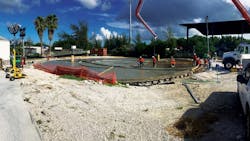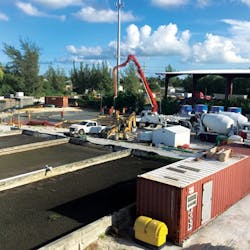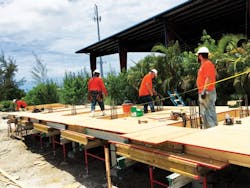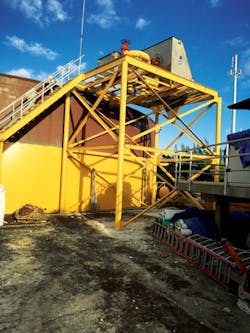About the author:
Michael Meyer is associate editor for WWD. Meyer can be reached at [email protected].
Key West, Fla., is one of the most scenic locales in the U.S. Situated in the Florida Keys just to the southwest of Miami, it is visited by millions of people seeking fun in the sun each year. But while Key West might seem like paradise to tourists and the approximately 30,000 residents of the island and the adjacent Stock Island (approximately half of which is part of the city of Key West), its environment can prove to be extremely hostile to those tasked with the island’s wastewater collection and treatment.
In response to these challenges, KW Resort Utilities Corp. has recently upgraded its treatment capabilities, and its efforts will help keep Key West a piece of heaven on earth for many years to come.
New Land, New Solutions
KW Resort Utilities began operation in the late 1960s. Key West’s population more than doubled during the 1950s and 1960s, due in large part to improvements to the Overseas Highway portion of U.S. Highway 1 as well as the filling of salt marshes on Stock Island with material dredged from surrounding waters. The utility’s treatment plant serviced the homes that were built on the new land on Stock Island, and as Key West’s popularity continued to grow during the 1970s, the utility found itself in need of an upgrade.
In 1983, KW Resort Utilities began a relationship with Davco (now an Evoqua brand), which provided a 250,000-gal-per-day (gpd) field-erected extended aeration treatment plant at a new two-acre location; the utility added an identical Davco plant in 1995 to expand its treatment capacity. In subsequent years, the island’s population and number of visitors continued to grow, but by the late 2000s, the utility was facing a different type of challenge.
“There was an advanced wastewater treatment [standard] that looked like it was going to be put into effect that we were preparing for, so the utility said we’ve got to change our treatment process from extended aeration to nutrient removal so that we can meet the new requirement, which is 5 ppm total suspended solids, 5 ppm biochemical oxygen demand, 3 ppm nitrogen and 1 ppm phosphorus,” said Chris Johnson, president of KW Resort Utilities. “In order to achieve those numbers, we were going to have to reconfigure the existing plants into a biological nutrient removal process.”
To aid in this effort, a 56,000-gal standalone clarifier was added to the plant in 2007.
“By constructing that clarifier tank, that gave us the hydraulic capacity that we needed to be able to take one of the other trains offline for a period of months to be able to reconfigure it into the new biological nutrient removal process, and then get it back online, and then take the other plant down, reconfigure it, and then bring it back up online,” Johnson said. “That was a large-scale project that took quite a bit of effort, because not only were we building wastewater plants, but we had to maintain treatment for our customers that were existing, and that’s always difficult.”
The overhaul was completed in 2010, just in time for the adoption of the new standard. By the middle of the 2010s, however, the facility once again needed to address issues related to its treatment capacity.
“We were starting to exceed 90% of capacity,” Johnson said. “It can be really, really difficult as you approach 100% to run plants, because the pumps aren’t sized big enough to push the water through. Just doing the treatment becomes difficult, and if anything isn’t normal, you don’t have that overhead—where if you’re at 60%, you have 40% overhead, you’ve got that to work with; when you’re at 90-some-odd-percent, you don’t have much overhead to work with.”
To address this issue, the utility added a third Davco plant, rated at 350,000 gpd, which went online in March 2017. By continuing to incorporate Davco products, the utility keeps its facility as easy to operate and maintain as possible.
“The advantage is you’re able to incrementally increase the size of your plant with the growth of your community, and still you’re able to keep an operational environment that’s familiar and uniform,” Johnson said. “It’s intuitive—once you know one plant, the other plants follow suit.”
Trouble in Paradise
The ever-increasing flow experienced by the utility is not the only concern facing Johnson and his team. Key West’s seaside location might delight locals and visitors, but it makes maintaining a water treatment facility extremely difficult.
“Our plants are within 50 ft of a sea wall, which is open ocean, so we’re exposed to the ocean air—the salt,” Johnson said. “That’s really the big challenge—the corrosive environment that salt water and being in a salt air environment poses.”
The destructive nature of the island’s salt air caught Johnson by surprise when he moved to Key West from Chicago.
“You leave your grill in your backyard in Chicago, it’s there for 12, 13 years, no problem. Down here? Six years and your grill is rusted out,” Johnson said. “Anything outside that can corrode will corrode in a salt water environment. Anytime you have a metal tank or a metal structure or anything metal, the key is to keep it as protected as possible, and if it does get compromised in some way, to address it quickly and proactively, so as to extend the life of the asset.”
In addition, the service area’s location in the former salt marshes of Stock Island makes the treatment process a challenge.
“Even with the fill material that they put in, they didn’t raise us to a very high elevation,” Johnson said. “We’re sitting at just a couple feet above sea level in a lot of areas on this island. It’s about as hostile an environment as you can get, because obviously in the ground there is tidal water, and then on top of it you have the freshwater lens. Anytime you have pipes underground, they’re susceptible to infiltration and intrusion that comes into your system; it eventually gets pumped by your lift stations or your vacuum system, and eventually it makes its way to the plant itself. Your plant is treating water that’s exposed to salt via the underground—the pipes and the lift stations themselves are submerged in the groundwater that’s a mix of tidal water and freshwater lens.”
And of course, Key West is located in an area that is prone to tropical storms and hurricanes, and those can have major impacts on the wastewater treatment process.
“When you have big rain events and hurricanes and that kind of thing, your systems are put under enormous stress,” Johnson said. “These kinds of things can happen at the worst possible time, just by their nature.”
Staying the Course
The KW Resort Utilities facility will continue to evolve—the utility is planning to rehabilitate the 1983 and 1995 plants in the near future, for example—and Davco products will certainly be a part of its future projects.
“The fact that we’ve kept with the same manufacturer and incrementally added as we’ve gone, obviously that saves costs,” Johnson said. “You’re able to build what you need when you need it, and as you need to expand, you’re able to build the next plant, and that’s really what this utility has done.”



